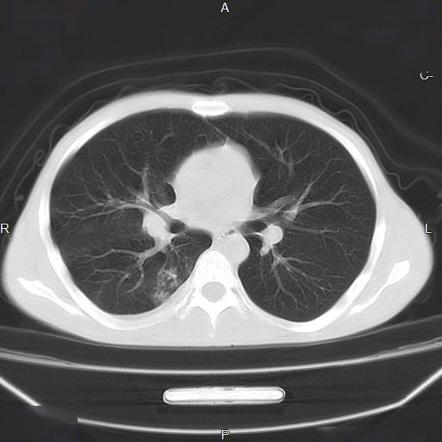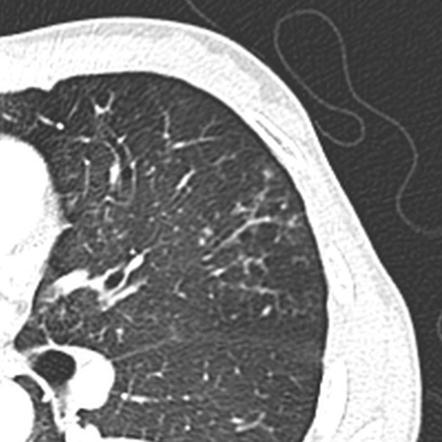tree in bud opacities radiology
Multiple causes for tree-in-bud TIB opacities have been reported. Recurrent infection and inflammation and the resulting chemical and cellular cascade lead to permanent architectural changes in the airways.

Tree In Bud Sign Lung Radiology Reference Article Radiopaedia Org
The tree-in-bud sign is a nonspecific imaging finding that implies impaction within bronchioles the smallest airway passages in the lung.
. Radiology scientific expert review panel. The tree-in-bud pattern is commonly seen at thin-section computed tomography CT of the lungs. It represents dilated and impacted mucus or pus-filled centrilobular bronchioles.
Bronchiectasis is permanent irreversible dilatation of the airways and occurs in a variety of pathologic processes. Histopathology The tree-in-bud pattern seen on CT represents radiologic sequelae of an infectious or inflammatory process. Centrilobular micronodules often seen as tree-in-bud opacities bronchial wall thickening.
Gross et al found distal airways disease in all lung specimens and bronchiolar dilatation in 36 of specimens71 HRCT demonstrates bronchiectasis or bronchial wall thickening in 2035 and centrilobular tree-in-bud opacities57 61 67Increased susceptibility to infection may be the underlying cause of bronchiectasis67. We investigated the pathological basis of the tree-in-bud lesion by reviewing the pathological specimens of bronchograms of normal lungs and contract radiographs of the post-mortem lungs manifesting active pulmonary. Tree in bud opacification refers to a sign on chest CT where small centrilobular nodules and corresponding small branches simulate the appearance of the end of a branch belonging to a tree that is in bud.
The tree-in-bud sign is a nonspecific imaging finding that implies impaction within bronchioles the smallest airway passages in the lung. The Oral Boards Primer CA2 NODULES MASH POX Metastatic disease Alveolar microlithiasis Silicosissiderosis Histoplasmosis Pox Varicella TREE IN BUD OPACITIES CT MIT Mucous plugging. Tree In Bud Opacities Radiology.
1 However since its first use in 1993 the tree-in-bud pattern has been associated with multiple etiologies. One method of classifying various forms of bronchiolitis is as follows 1. On CT scan it is identified in 95 of cases making HRCT the imaging modality of choice to detect early bronchogenic spread329 Typical findings include 2- to 4-mm centrilobular nodules and tree-in-bud branching opacities sharply marginated linear branching opacities around terminal and respiratory bronchioles.
However to our knowledge the relative frequencies of the causes have not been evaluated. Tree-in-bud describes the appearance of an irregular and often nodular branching structure most easily identified in the lung periphery. 8081 On CT the tree-in-bud pattern manifests as small 24 mm centrilobular well-defined nodules connected to linear branching opacities that.
In centrilobular nodules the recognition of tree-in-bud is of value for narrowing the differential diagnosis. The tree-in-bud sign has been described in cases of acute aspiration 13. Cavitation is also.
Nodular opacities with tree-in-bud appearance can be associated with other changes in lung parenchyma-such as thickening of the bronchial walls consolidations andor areas of. It was initially used by JG Im to describe the endobronchial spread of Mycobacterium tuberculosis. Malignancy can be associated with the tree-in-bud sign.
Tree-in-bud TIB opacities are a common imaging finding on thoracic CT scan. In radiology the tree-in-bud sign is a finding on a CT scan that indicates some degree of airway obstruction. Tree-in-bud pattern seen on high-resolution CT HRCT indicates dilatation of bronchioles and their filling by mucus pus or fluid.
Inspiratory series were evaluated for ancillary findings including the presence of bronchiectasis tree-in-bud opacities nontree-in-bud centrilobular. It consists of small centrilobular nodules of soft-tissue attenuation connected to multiple branching linear structures of similar caliber that originate from a. Bronchiolar dilatation often referred to as bronchiolectasis mosaic attenuation andor air trapping if expiratory imaging is used Classification.
The purpose of this study was to determine the relative frequency of causes of TIB opacities and identify patterns of disease associated with TIB opacities. TBMAI Tumor emboli rare Chapter 02_32_58_F 22006 236 PM Page 50. Uncommonly this pattern can be seen in other entities that cause luminal impaction bronchiolar dilatation or wall thickening including cystic fibrosis immune deficiency inflammatory bowel disease and diffuse panbronchiolitis.
The majority of the cases of chronic occult aspiration in this series showed a predominant pattern of bronchial wall thickening centrilobular nodules and tree-in-bud opacities usually with lower lung zone predominance Figures 1A and 1B. However some cases showed a diffuse distribution of disease throughout the lungs and in a few there. AspirationKartageners Inflammatory plugging PUS.
The Radiology Information System was searched for the term air trapping from January 1 2010 to December 31 2010 identifying a total of 1295 examinations. Originally and still often thought to be specific to endobronchial Tb the sign is actually non-specific and is the manifestation of pus mucus fluid or other. These small clustered branching and nodular opacities represent terminal airway mucous impaction with adjacent peribronchiolar inflammation.
Thus the bronchioles resemble a branching or budding tree and are usually somewhat nodular in appearance. In radiology the tree-in-bud sign is a finding on a CT scan that indicates some degree of airway obstruction. Bronchiectasis can confer substantial potential morbidity usually secondary to recurrent infection.
Tree in bud opacification refers to a sign on chest ct where small centrilobular nodules and corresponding small branches simulate the appearance of the end of a branch belonging to a tree that is in bud. The tree-in-bud-pattern of images on thin-section lung CT is defined by centrilobular branching structures that resemble a budding tree. Intravascular pulmonary tumor embolism often occurs in cancers of the breast liver kidney stomach prostate and ovaries and can lead to the tree-in-bud sign in HRCT 214.
View Of Tree In Bud The Southwest Respiratory And Critical Care Chronicles

Tree In Bud Sign Lung Radiology Reference Article Radiopaedia Org

Tree In Bud Pattern Radiology Case Radiopaedia Org

Tree In Bud Pattern Radiology Case Radiopaedia Org

Tree In Bud Sign Lung Radiology Reference Article Radiopaedia Org

References In Causes And Imaging Patterns Of Tree In Bud Opacities Chest